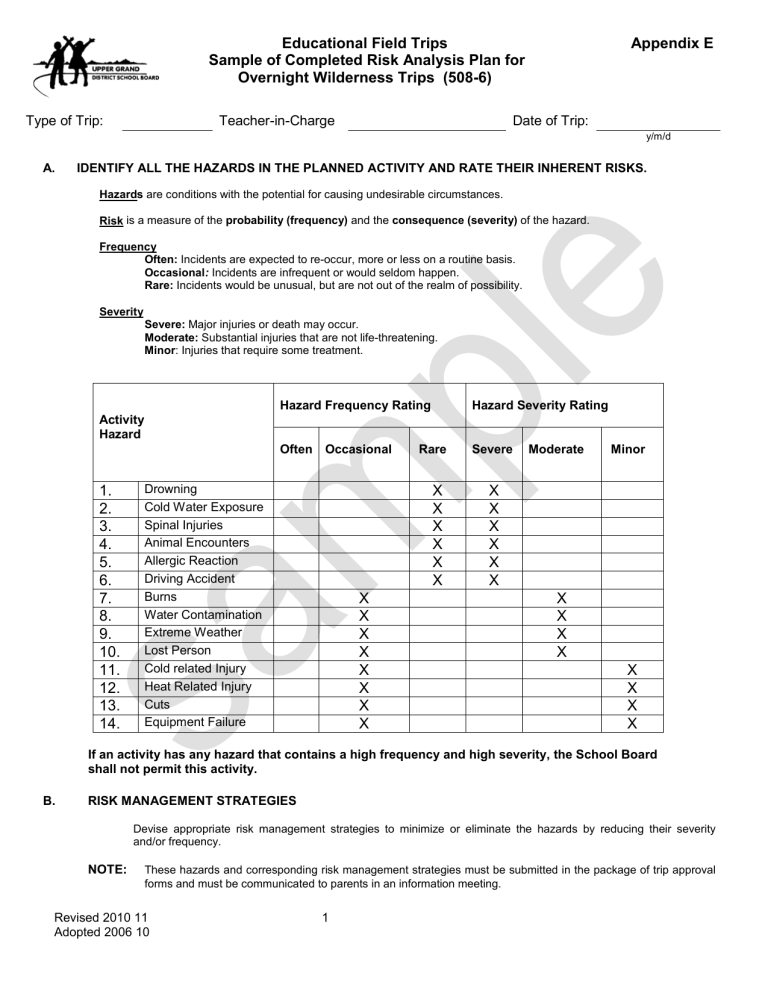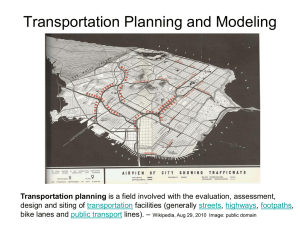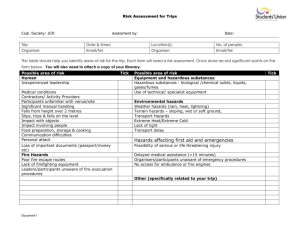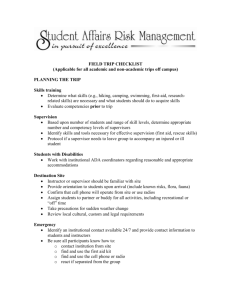Educational Field Trips Appendix E Sample of Completed Risk Analysis Plan for

Educational Field Trips
Sample of Completed Risk Analysis Plan for
Overnight Wilderness Trips (508-6)
Appendix E
Type of Trip: Teacher-in-Charge Date of Trip: y/m/d
A. IDENTIFY ALL THE HAZARDS IN THE PLANNED ACTIVITY AND RATE THEIR INHERENT RISKS.
Hazard s are conditions with the potential for causing undesirable circumstances.
Risk is a measure of the probability (frequency) and the consequence (severity) of the hazard.
Frequency
Often: Incidents are expected to re-occur, more or less on a routine basis.
Occasional: Incidents are infrequent or would seldom happen.
Rare: Incidents would be unusual, but are not out of the realm of possibility.
Severity
Severe: Major injuries or death may occur.
Moderate: Substantial injuries that are not life-threatening.
Minor : Injuries that require some treatment.
Activity
Hazard
Hazard Frequency Rating
Often Occasional Rare
Hazard Severity Rating
Severe Moderate Minor
1. Drowning
2. Cold Water Exposure
3. Spinal Injuries
4. Animal Encounters
5. Allergic Reaction
X
X
X
X
X
X
X
X
X
X
6. Driving Accident
7.
8.
Burns
Water Contamination
X
X
X
X X
X
X
X 9. Extreme Weather
10. Lost Person
11. Cold related Injury
12. Heat Related Injury
X
X
X
X
13. Cuts
14. Equipment Failure
X
X
X
X
X
X
If an activity has any hazard that contains a high frequency and high severity, the School Board shall not permit this activity.
B. RISK MANAGEMENT STRATEGIES
Devise appropriate risk management strategies to minimize or eliminate the hazards by reducing their severity and/or frequency.
NOTE: These hazards and corresponding risk management strategies must be submitted in the package of trip approval forms and must be communicated to parents in an information meeting.
Revised 2010 11
Adopted 2006 10
1
Educational Field Trips
Sample of Completed Risk Analysis Plan for
Overnight Wilderness Trips (508-6)
Appendix E
These are samples of Activity Hazards to be used as guidelines in completing form 508-6 Risk
Analysis Plan For Overnight Wilderness Trips.
1. Drowning
•
swim assessment – prior to trip to identify weak swimmers – all staff informed of swimming levels of students
•
Personal Floatation Device (PFD) – worn at all times in canoes and always completely zipped and buckled up
•
swims – life guarded by qualified supervisors in designated area only – areas will be checked out in advance for swimming hazards – lifeguards will have a throw bag with them
2. Extended Exposure to Cold Water (due to flipping a canoe)
•
group will always travel within 400 meters of shore
•
Magnetawan canoe route is specifically chosen for having no large lakes where waves and wind become any kind of safety factor
•
T rescue technique will be used by instructors to get students out of the water and back into their boat
3. Athletic Injuries (Head and Spinal Chord)
•
no diving will be allowed at any time during the trip from any height
•
proper technique instructed for carrying canoe and wanigan Tump line shall not come below forehead when carrying wanigan
4. Animal Encounters
•
no food or gum will be eaten in tents at any time
•
menu will not have highly smelly and/or greasy food on it
•
food and garbage will be hung up in packs at night
5. Allergic Reactions
•
medical lists will be studied in advance by the Teacher(s)-in-Charge and information transferred to all supervisors
•
EpiPens will be carried by students identified on the medical list. A second EpiPen should be carried by the Supervisor.
•
Benadryl is carried in First-Aid kit to give to anyone if a reaction has begun
•
menu is designed to avoid highly allergic foods
Revised 2010 11
Adopted 2006 10
2
Educational Field Trips
Sample of Completed Risk Analysis Plan for
Overnight Wilderness Trips (508-6)
Appendix E
6. Driving Accident
•
a professional school bus company will always be hired to transport students on the trip
•
if a student must ride in a privately-owned vehicle, it will be driven by a teacher of the school board or designated supervisor.
7. Burns
•
oven mitts or hand protection will be provided for cooking
•
fire irons will be inspected for stability by supervisors prior to cooking
•
fall area of large cooking pot will be clear
•
no horseplay with or near the fire
8. Water Contamination
•
all drinking water will be purified using the filter pump and bladder system provided
•
all water used in cooking (e.g., for pasta) will be boiled for a minimum of 10 minutes
•
proper hygiene will be encouraged at all times - students will wash hands after all bathroom visits – each group will be provided with a community soap and shampoo
•
dishes will be cleaned using the two dish tub system; one with hot soapy water and one with hot rinse water – changing of the dish water will be encouraged
9. Extreme Weather
•
no travelling by canoe will be permitted during thunderstorms
•
if extreme weather sets in (high winds, extreme cold, or heavy rains) supervisors will be encouraged to “sit it out” and set up a tarp rather than trudge on
•
all groups shall carry a 9’ by 12’ tarp
•
in case of severe lightning (once every 15 seconds) all persons will spread out on shore, away from tree roots, crouch low, and away from potential branches falling
10. Lost Person
•
students shall not wander far from the campsite (always keep the campsite within visual contact)
•
students will be instructed to remain where they are and not to wander if they become lost
•
whistles will be available in all canoes
Revised 2010 11
Adopted 2006 10
3
Educational Field Trips
Sample of Completed Risk Analysis Plan for
Overnight Wilderness Trips (508-6)
Appendix E
11. Cold Related Injuries
•
proper dress will be taught in advance of the trip
•
good rain gear is a must
•
waterproofing technique of sleeping bags and personal gear will be taught in advance of the trip and checked
•
Supervisors will check all clothing and sleeping bags prior to the trip and ensure that an extra down sleeping bag is available
12. Heat Related Injuries
•
hat and sun-screen will be on clothing list and encouraged to be worn on the trip
•
students will be encouraged to remain hydrated at all times (filtering water into bladder will be part of daily chores)
13. Cuts
•
proper sawing technique and practice will take place in advance of the trip
•
discussion of jack-knife use will occur making sure there is always a clear “slip” area and that students always cut away from themselves
•
hands must be 6 inches from swede saw blade when cutting
14. Equipment Failure
•
only good quality equipment will be purchased
•
all equipment will be checked annually before the trip
•
extra rope and a repair kit will be carried by the supervisors
Revised 2010 11
Adopted 2006 10
4




